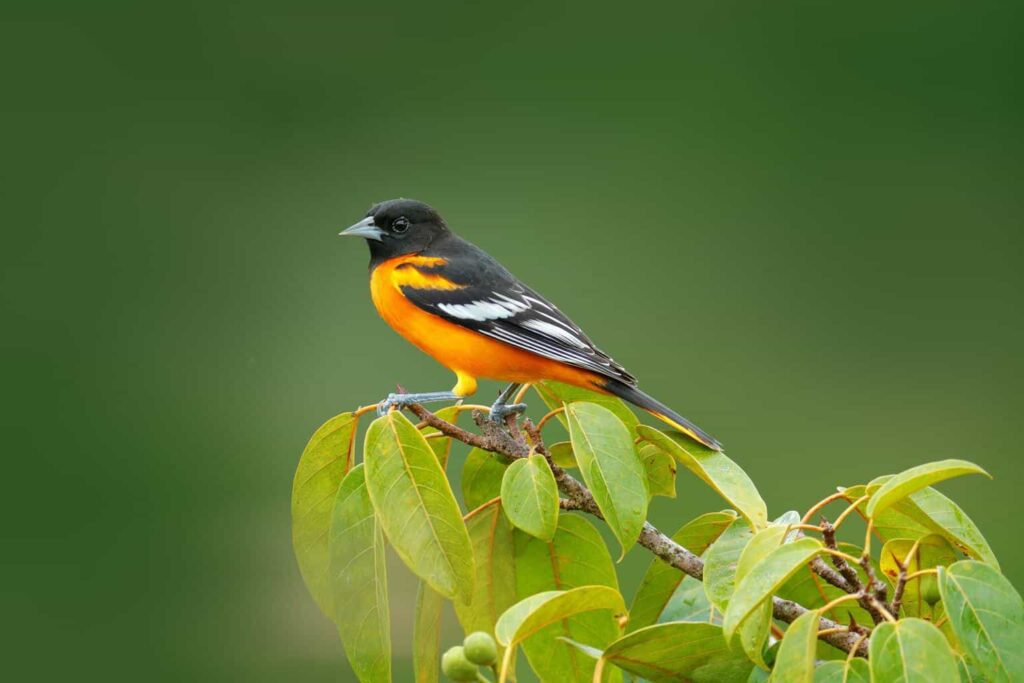Just take one look at the breathtaking skies of Arkansas and you’ll notice that it doesn’t lack color, as the state is home to over 419 species of birds.
From red and blue to orange, yellow, and other vibrant colors, the bird species in the Wonder State are breathing rainbows among the clouds.
If you’re an avid birder based here or you plan on visiting the state soon, you ought to stick around as we’re about to shed light on 26 must-see birds in Arkansas.
Red Birds in Arkansas
Northern Cardinal

- Scientific name: Cardinalis cardinalis
- Length: 8.3 – 9.1 in
- Weight: 1.19 – 2.29 oz
- Wingspan: 9.8 – 12.2 in
Many birds shed their eye-catching feathers in the winter so they can grow more “serviceable” feathers to keep them warm on cold nights. Lucky for us, the Northern cardinal doesn’t do that. Instead, it holds on to its mesmerizing red feathers regardless of the season.
Moreover, the Northern Cardinal doesn’t migrate. So, if you live in Arkansas, you’ll have a year-round opportunity to spot this bird.
The Northern Cardinal is easily attracted to bird feeders. While all kinds of bird feeders seem to work, if you want to better your chances of seeing this scarlet wonder, the Northern Cardinal has a thing for sunflower seeds.
House Finch

- Scientific name: Haemorhous mexicanus
- Length: 5 – 6 in
- Weight: 0.5 – 0.9 oz
- Wingspan: 8 – 10 in
This bird has experienced karma firsthand. House Finches are known to overpower Purple Finches, kicking them out of their territory. But a much smaller foe has been avenging the Purple Finches. There is a pesky bacteria that plagues House Finches, causing eye inflammation, which makes it hard for these birds to seek food.
House Finches have overcome this problem by seeking food in flocks. So, even if a diseased bird is having a hard time locating food, all it has to do is stick with the flock, and dinner is served. It better be careful not to infect its fellow hunters, though. Social distancing, people – er, birds!
Purple Finch

- Scientific name: Haemorhous purpureus
- Length: 4.7 – 6.3 in
- Weight: 0.6 – 1.1 oz
- Wingspan: 8.7 – 10.2 in
Even though it’s called the Purple Finch, this bird is actually red. That’s why you may have a hard time distinguishing between this finch and the previously mentioned House Finch.
To tell them apart, note that the Purple Finch has a more extensive red color throughout its plumage. In contrast, the House Finch’s red is confined to areas like the crown, breast, and throat.
The flanks also help you differentiate between the two species: the Purple Finch has red flanks, whereas the House Finch has brown-streaked ones.
Summer Tanager
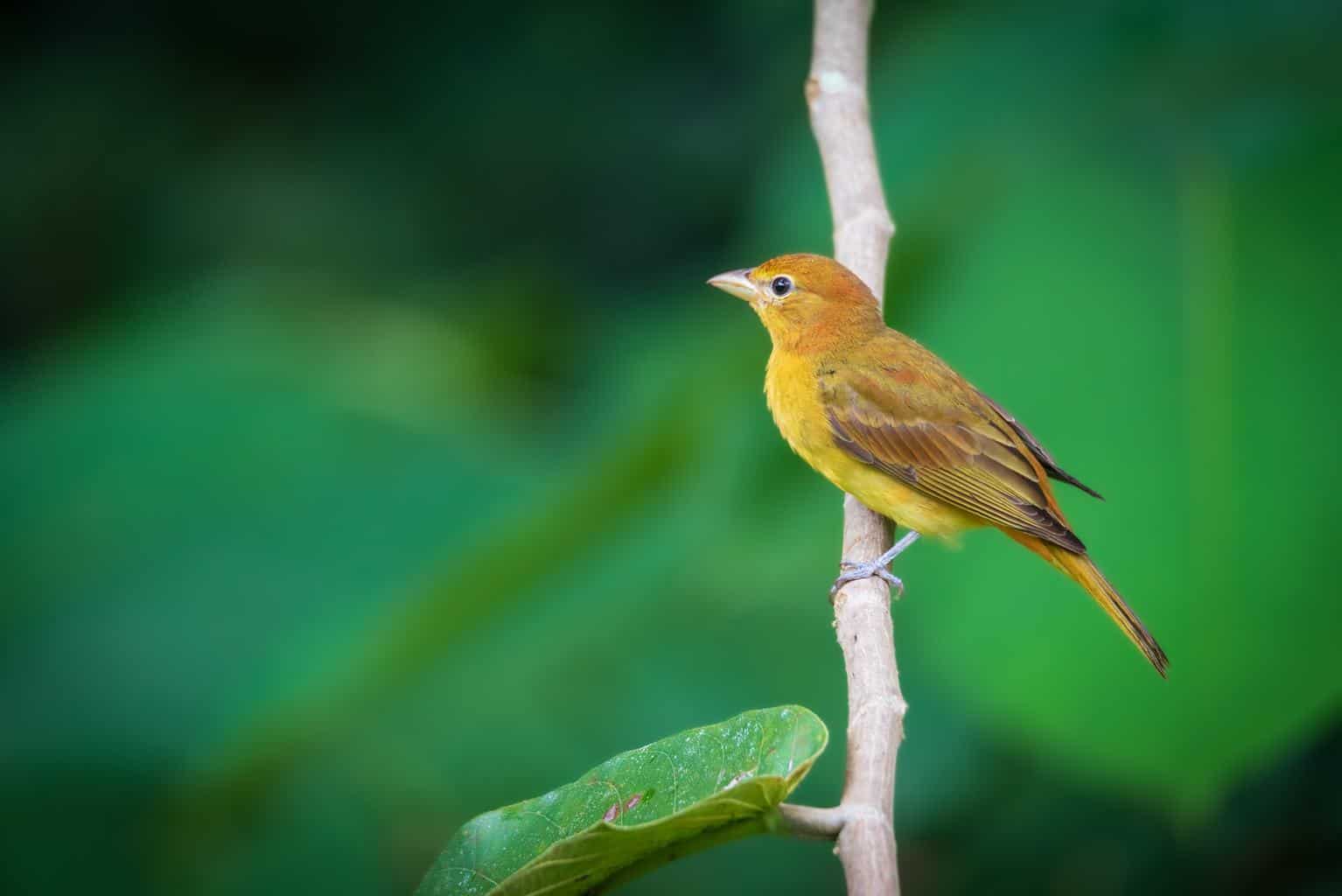
- Scientific name: Piranga rubra
- Length: 6.7 in
- Weight: 1.0 oz
- Wingspan: 11 – 11.8 in
The only entirely red bird in all of North America is the Summer Tanager. To be more specific, the adult male Summer Tanager is all red, with females and immature males being bright yellow.
They love to eat bees and wasps. You might ask, “won’t they get stung when trying to eat those things?”
Well, bees can’t sting the Summer Tanager, because the Summer Tanager catches bees by surprise, and before eating them, rubs their bodies against tree branches to get rid of the stinger.
Blue Birds in Arkansas
Blue Jay

- Scientific name: Cyanocitta cristata
- Length: 9 – 12 in
- Weight: 2.5 – 3.5 oz
- Wingspan: 13 – 17 in
This bird knows the value of adaptability. Even after the clearing of the Eastern forest, the Blue Jay managed to survive by learning how to nest in cities. After establishing themselves in urban life, Blue Jays decided not to settle, expanding their reach towards the Northwest.
Life in the city is hard. That’s why this bird never squanders an opportunity to eat or bring food home to its chicks. Consequently, it’s common to spot a Blue Jay collecting food from your backyard bird feeder. You can also find the Blue Jay in city parks where it can get back to nature.
Blue Grosbeak

- Scientific name: Passerina caerulea
- Length: 5.5 – 7.5 in
- Weight: 0.92 – 1.11 oz
- Wingspan: 10 – 11 in
Always seeking shelter in shrubs, the Blue Grosbeak isn’t the easiest to spot—unless you hear it sing. Follow the symphony and it’ll lead you straight to the instrument. What’s more, the bird has an unmistakable silver bill.
The Blue Grosbeak has a preference for shrubs that may end up being to your advantage. If you have a shrubby backyard, all you need to do is install bird feeders filled with grains and seeds. Then lay back and watch the Blue Grosbeak come to you.
Indigo Bunting
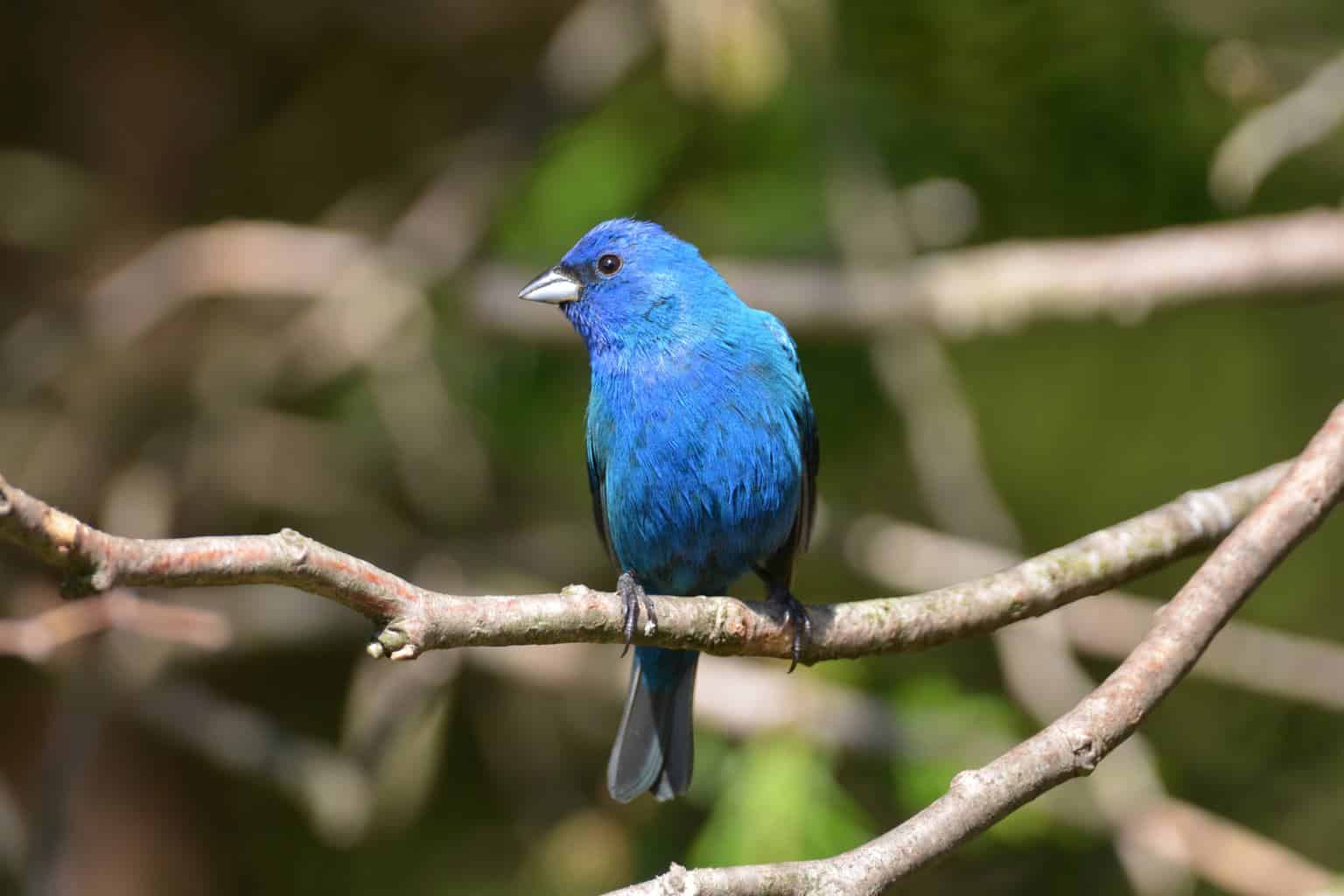
- Scientific name: Passerina cyanea
- Length: 4.5 – 5.1 in
- Weight: 0.4 – 0.75 oz
- Wingspan: 7.1 – 9.1 in
Indigo Buntings are anything but faint-hearted. These birds reside on the edges of railways, highways, and even perch atop power lines! That’s pretty much all of the scariest environments for a bird.
The cold doesn’t affect them, either. In winter, these birds face the cold wind head-on. Also, these birds don’t seek shelter in compact forests in winter; the Indigo Bunting prefers open habitats.
Eastern Bluebird

- Scientific name: Sialia sialis
- Length: 6.3 – 8.3 in
- Weight: 0.95 – 1.2 oz
- Wingspan: 9.8 – 12.6 in
With its characteristic blue back and orange chest, the Eastern bluebird is the most widespread of its species. It lives in a wide range of habitats, from roadsides and farms, to open pine woods and shrubs.
To hunt, Eastern bluebirds assume low perches; a vantage point allowing them to identify potential insect prey. Eastern bluebirds hover low over the insect and catch it while flying. It can also catch flying insects in mid-air.
Green Birds in Arkansas
Green Heron

- Scientific name: Butorides virescens
- Length: 17 in
- Weight: 8.5 oz
- Wingspan: 25.2 – 26.8 in
Watching it cruise by on the water, you may mistake the Green Heron for a small goose. But the distinctive dark green color on its wings will tell you that you’ve spotted something entirely different.
The Green Heron is often found at the banks of streams because it feeds on fish. The bill of this bird dips in and out of water more than a teabag. All it has to do is dip its large bill in the water and snatch an unsuspecting fish passing by.
The diet of the Green Heron isn’t strictly fish, though; it also includes other water creatures, like crustaceans and mollusks. Even insects, reptiles, and amphibians can be meals for the Green Heron.
Mallard

- Scientific name: Anas platyrhynchos
- Length: 20 – 26 in
- Weight: 24 – 56 oz
- Wingspan: 32 – 39 in
This duck may not be predominantly green, but the bright green head of the adult male (the drake) is noteworthy.
The drake doesn’t quack. Much like Drake, the rapper, you can sense some auto-tune going on with this bird’s music. In the case of drake the duck, however, this sound is due to the nasal involvement, which gives its calls a distinctive tone.
Far from being musical, the drake uses these calls to scare away other males during the breeding season.
White-Eyed Vireo

- Scientific name: Vireo griseus
- Length: 4.3 – 5.1 in
- Weight: 0.3 – 0.5 oz
- Wingspan: 6.7 in
If you spot a bird rocking yellow eyeglasses, know that you’ve seen a White-Eyed Vireo. The yellow coloring on the bird’s eyes stands out from its olive-green body, making this yellow “eyewear” a very distinctive feature. If you take a closer look at these birds, you’ll see their uncommonly white iris.
When proposing to a female, the male of this species doesn’t offer a ring; it carves out a territory of its own. The female will then take a tour through the different territories of her suitors until she finds the one that suits her the best.
Ruby-Throated Hummingbird
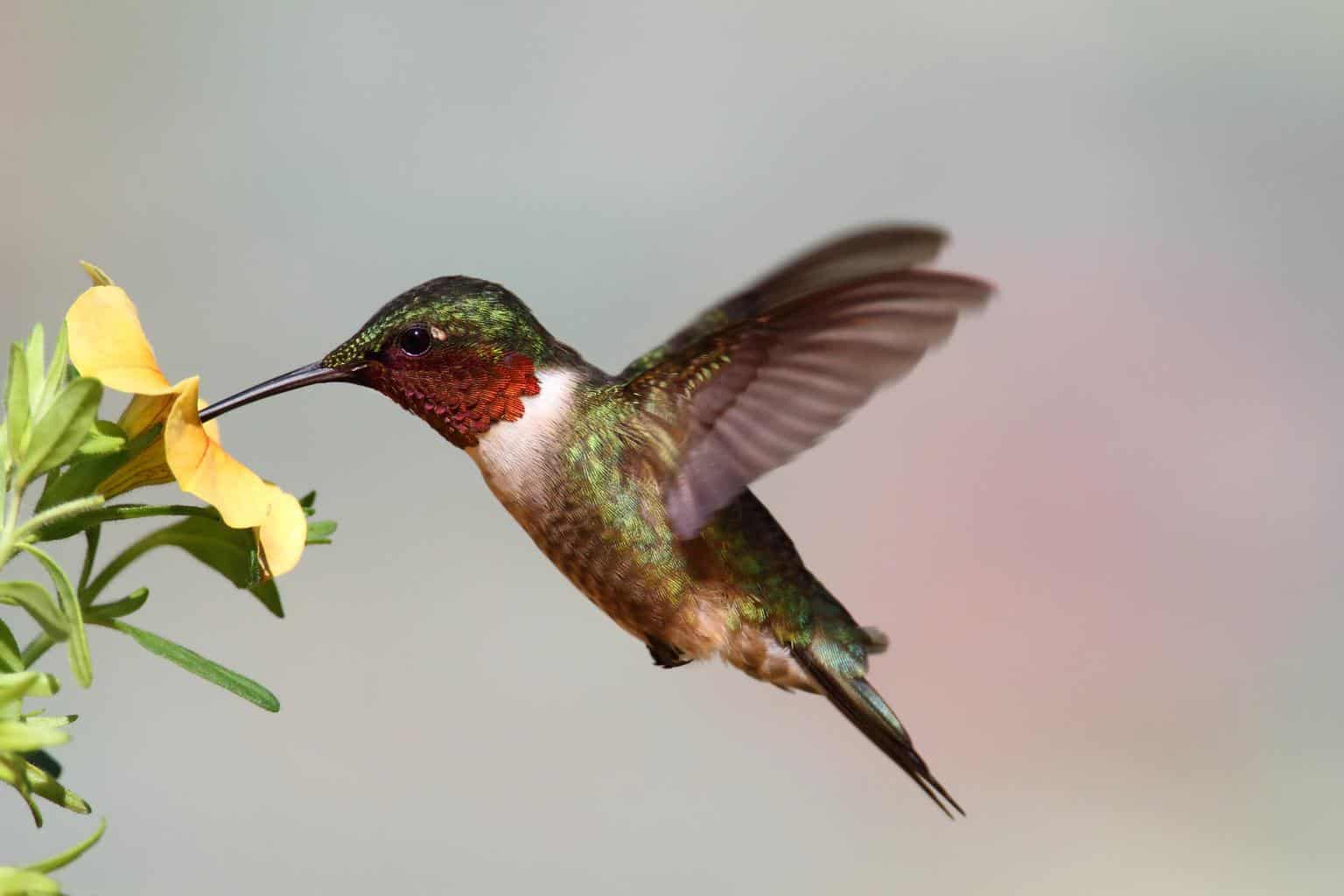
- Scientific name: Archilochus colubris
- Length: 2.8 – 3.5 in
- Weight: 0.071 – 0.212 oz
- Wingspan: 3.1 – 4.3 in
The mixture of green upperparts, white underparts, and a bright red neck gives this hummingbird a unique color scheme. And this tiny bird packs it all in a very small area!
The red feathers around this bird’s neck aren’t only for show; the male repeatedly erects those red feathers as a part of his display to attract the female. I guess they’re for show, after all.
Once he wins the girl over, though, the male Ruby-Throated Hummingbird isn’t a very good father. He walks out (flies out?) on the female, leaving her to raise the chicks alone.
Orange Birds in Arkansas
Baltimore Oriole
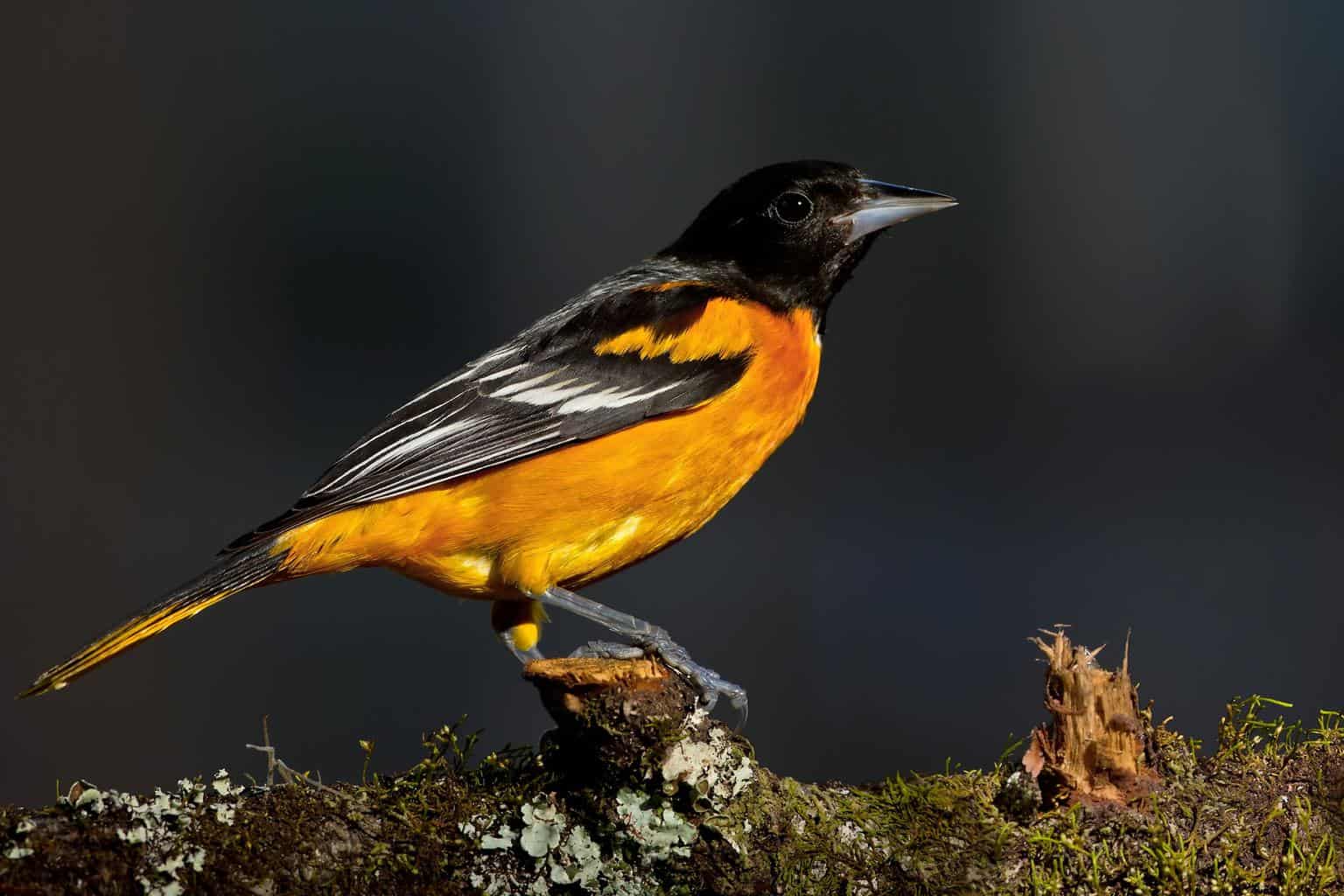
- Scientific name: Icterus galbula
- Length: 6.7 – 8.7 in
- Weight: 1.19 oz
- Wingspan: 9.1 – 12.6 in
Strolling downtown in the middle of the day, you seek shade under a tree in a nearby park. Here, you see a paper bag dangling from a tree. It’s not a paper bag! You’ve stumbled on a Baltimore Oriole’s nest, and you’re likely about to see a flaming orange, almost mystical bird flutter out of that nest!
Aside from nesting in trees in towns, the Baltimore Oriole also dwells in groves and open woods. When it comes to seeking food, the Baltimore Oriole is pretty resourceful. It can navigate dense vegetation in search of crawling insects.
Alternatively, it can fly acrobatically in the air to catch a flying insect by surprise. It also takes a page out of the bee’s book and drinks the nectar in flowers.
Orchard Oriole

- Scientific name: Icterus spurius
- Length: 5.9 – 7.1 in
- Weight: 0.6 – 1.0 oz
- Wingspan: 9.8 in
Six days is all the female Orchard Oriole needs to build a nest for her offspring. Using anything from grass to animal hair and feathers, the female manages to build a cup-shaped nest hanging from a tree.
You may come across this orange-black bird in parks and agricultural lands since it has become adapted to interacting with humans.
American Robin

- Scientific name: Turdus migratorius
- Length: 9.1 – 11. in
- Weight: 2.7 oz
- Wingspan: 12 – 16 in
Some birds love having feeders to snack from—American Robins only need a lawn. For American robins, a lawn is a feast full of appetizing food, especially delicious worms. Given how active this bird is, insects in the grass have little chance of getting away.
Not only are American robins early birds, but they also reappear right after the winter ends, without any undue delay.
You’ll know this bird as soon as you see it, as the combination of the orange chest and the dark back is unmistakable.
Eastern Towhee

- Scientific name: Pipilo erythrophthalmus
- Length: 6.8 – 9.1 in
- Weight: 1.1 – 1.9 oz
- Wingspan: 7.9 – 11.8 in
This bird may not be entirely orange, but the wide orange streaks running down its sides are surely something to speak of. Another thing worth noting is that male Eastern Towhees have what it takes to be popular singers.
Just watch as it perches atop the highest thing it can find, before singing at the top of its lungs—this is an American Idol winner in the making!
Besides singing, there’s another telltale sound pointing you towards this bird: scratching. When searching for food, the Eastern Towhee diligently scratches in the leaf litter beneath trees.
Cooper’s Hawk

- Scientific name: Accipiter cooperii
- Length: 14 – 20 in
- Weight: 9.9 – 16.68 oz
- Wingspan: 24 – 39 in
What makes the orange color of this bird unique is how it seamlessly blends with both brown and gray, creating an astounding gradient.
Despite its 3-foot wings that make it seem as though no prey can get away from it, Cooper’s Hawk still resorts to stealth.
Sparing itself the chase, Cooper’s Hawk hunts in dense vegetation, where it can sneak up on its prey. Once in range, the hawk quickly catches the prey with its feet and squeezes it to death.
Yellow Birds in Arkansas
Prothonotary Warbler
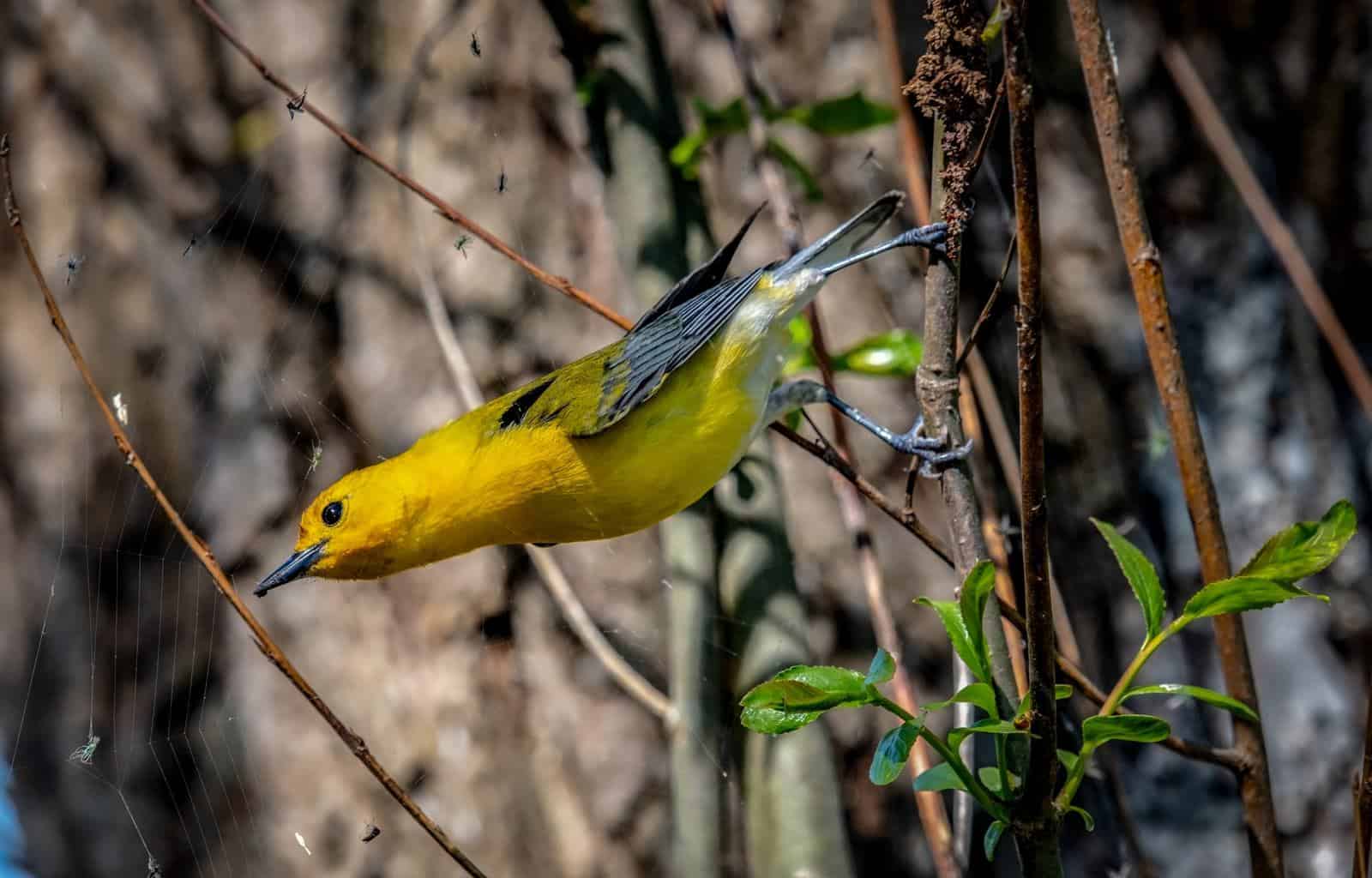
- Scientific name: Protonotaria citrea
- Length: 5.1 in
- Weight: 0.44 oz
- Wingspan: 8.75 in
The Prothonotary Warbler can be found near water. Not only do these birds inhabit areas near lakes and creeks, but they even perch next to pools and house ponds. This is probably one of the few birds that you can attract easier with water than food.
This affiliation they have with humans doesn’t stop at perching near pools. The Prothonotary Warbler can leverage any wooden box or milk carton lying around and use it as a breeding cavity.
However, these birds consider manmade cavities as a plan B, with most of their breeding taking place in tree cavities whenever possible.
Pine Warbler

- Scientific name: Setophaga pinus
- Length: 5 – 5.75 in
- Weight: 0.42 oz
- Wingspan: 8.75 in
Birds of a feather flock together—that’s the motto of Pine Warblers. Whether migratory or resident, groups of warblers usually meet and fly together, amounting to flocks of 50 to 100 birds—what a scene to behold!
Besides being able to spot their charming flocks in the sky, Pine Warblers aren’t easy to find. That’s because they usually make their way through the high branches of trees, and don’t feel comfortable unless they’re surrounded by pines on all sides. They’re called “Pine” Warblers for a reason!
Eastern Meadowlark

- Scientific name: Sturnella magna
- Length: 7.5 – 11 in
- Weight: 2.7 – 5.3 oz
- Wingspan: 14 – 16 in
While clearing forests is generally harmful to birds, the Eastern Meadowlark is one of the few birds that thrive due to such clearings. When forests were cleared to give place to farmlands in the 1700s, Eastern Meadowlark numbers started an upward curve that hasn’t stopped.
When standing erect, this bird, with its characteristic black v-shape around its throat which somehow meshes well with the bright yellow surrounding it, looks like a gentleman with a yellow shirt and a black necktie.
Yellow-Breasted Chat

- Scientific name: Icteria virens
- Length: 6.7 – 7.5 in
- Weight: 0.71 – 1.19 oz
- Wingspan: 9.1 – 10.6 in
True to its name, the Yellow-Breasted Chat has a yellow chest, throat, and chin. The face and upperparts, on the other hand, are mostly grayish.
To attract the female, the male Chat uses the oldest trick in the book: he sings her a song. The songs in the male’s repertoire are important factors in the female’s decision to mate.
Once he gets his wish, however, the male tends to become complacent, singing to his mate way less than before. But the Yellow-Breasted Chat uses singing as a method of marking its territory, as well. So, maybe the male is redirecting all the singing towards protecting his mate.
American Goldfinch

- Scientific name: Spinus tristis
- Length: 4.3 – 5.5 in
- Weight: 0.39 – 0.71 oz
- Wingspan: 7.5 – 8.7 in
If you see a yellow wave of birds meandering through the sky, then know you’ve set eyes on migrating flocks of American Goldfinches.
Since they migrate back and forth across short distances, you may experience multiple sightings of them if you live in Arkansas.
When faced with a predator, an American Goldfinch isn’t aggressive. Instead, it dedicates its energy to warn fellow Goldfinches so they can get away. A pretty selfless bird, indeed!
Other Birds to Watch for in Arkansas
Carolina Chickadee
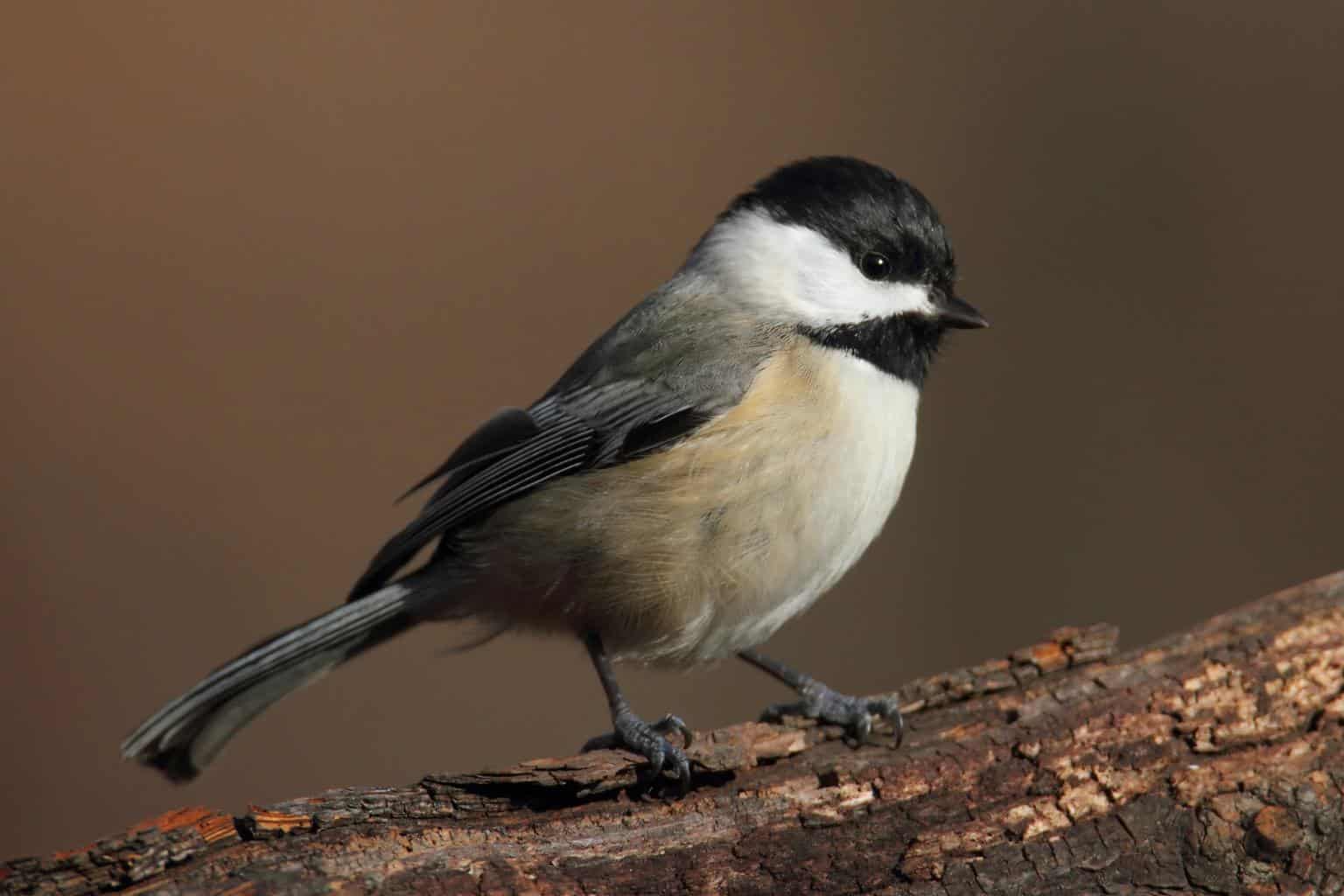
- Scientific name: Poecile carolinensis
- Length: 4.5 – 5.1 in
- Weight: 0.32 – 0.42 oz
- Wingspan: 6 – 8 in
Although the Carolina Chickadee isn’t usually attracted to bird feeders, it won’t be able to escape the allure of sunflower seeds.
The Carolina Chickadee is one of the few birds that mate with a different breed. It interbreeds with Black-Capped Chickadee, giving their offspring the combined traits of both birds. Consequently, distinguishing between the two of them is quite the head-scratcher for birdwatchers.
House Sparrow

- Scientific name: Passer domesticus
- Length: 6.3 in
- Weight: 0.85 – 1.39 oz
- Wingspan: 7.5 – 9.8 in
Don’t let its small size fool you, the House Sparrow is the reason why many bird species got evicted from their rural homes. It’s quite the bully!
The House Sparrow’s favorite food is fruit. Despite being considered a pest itself, the House Sparrow is beneficial when it comes to pest control, feeding on well-established pests like moths and cotton caterpillars.
Brown-Headed Cowbird

- Scientific name: Molothrus ater
- Length: 6.3 – 8.7 in
- Weight: 1.1 – 2.1 oz
- Wingspan: 14 in
These birds are so stocky you may think they’ve been hitting the gym lately. But knowing that the female lays more than three dozen eggs per summer, you’ll understand that they need that strength.
A surplus of strength is a dangerous thing, though, because with power comes responsibility, and the Brown-Headed Cowbird is far from responsible. This bird makes a habit of destroying the eggs of other birds, causing the numbers of already endangered species to drop even more.
Downy Woodpecker

- Scientific name: Dryobates pubescens
- Length: 5.5 – 7.1 in
- Weight: 0.71 – 1.16 oz
- Wingspan: 9.8 – 12.2 in
Being short and small has its perks. Who better to testify to this than our Downy Woodpecker friend?
This bird’s tiny size enables it to tap into food hidden in small branches, which would have otherwise been inaccessible.
It’s no wonder, then, that insects comprise the overwhelming majority of this woodpecker’s diet. Bur if you want to attract it to your bird feeder, suet is the way to go.
Final Words
Arkansas has a plethora of birds on its land, in its water, and its skies! If you’re already a resident, congratulations! You can enjoy great bird watching all year round. And the ease with which you can attract birds to your home makes it that much easier to pursue this pastime.
If you don’t live in Arkansas, think about taking a trip to Bill Clinton’s home state and check out the wonderful variety of birds in Arkansas!

